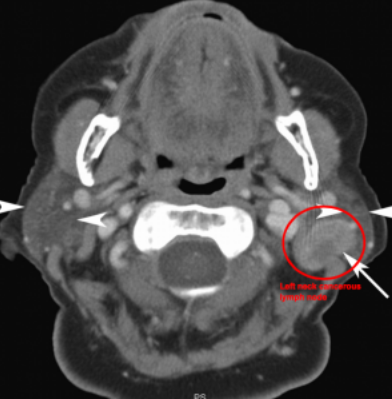

In adults over 40 years of age, lymph nodes that are long-lasting are associated with a 4 percent risk of cancer. While swollen lymph nodes are more commonly due to viral infections, there is a chance that they could indicate cancer, although rare. If they are persistently swollen for more than two weeks, this can mean a more serious infection, or cancerous cells could be causing protrusion and inflammation. Pay attention to where and for how long your nodes feel enlarged. Regions with swollen nodes indicate where your body is fighting disease or infection. This is usually due to sinus infections or the common cold, but some other frequent reasons why lymph nodes become swollen:

Here it is filtered with infection-fighting white blood cells and released back into the bloodstream. On most occasions, swelling occurs in the nodes behind the ears and on the neck. Dangerous substances travel to the nodes by lymph fluid. Lymph nodes become swollen when they are actively fighting infection and illness. It can be helpful to know where your lymph nodes are located to get ahead of potentially serious ailments. Paying close attention to swelling in your nodes is important as swelling indicates that your body is dealing with sickness. Symptoms that are commonly associated with lymph node swelling include: You can check for lymph node swelling by gently pressing over areas with clusters, such as the sides of your neck or around your armpit. Lymph nodes largely go unnoticed until they are enlarged or swollen due to them trying to fight infection and illness. Lymph nodes are found in the following five areas of the body in clusters: They play a major role in our ability to fight infection and disease. Sometimes referred to as lymph glands, their job is to collect and drain fluid from our tissues. Lymph nodes are small, kidney bean-shaped structures. They use lymph fluid, which is partially made up of white blood cells, or lymphocytes, to filter foreign and dangerous substances. There are about 500 to 600 lymph nodes in our bodies. Keep reading to learn more about the important function of your lymphatic system and what having swollen nodes means for your health.
Lymph nodes in throat how to#
Having a basic understanding of this system is essential in learning how to spot abnormalities. Your lymphatic system also helps maintain fluid drainage and aids in fat absorption. As a component of the immune system, lymphatics play a key part in protecting you against illnesses. Understanding the role of lymphatics in your body is important as it has three major functions that affect your day-to-day routine. Deltoideopectoral nodes: Situated between the pectoralis major and deltoid muscles inferior to the clavicle.Your lymphatic system plays a key role in your overall health and wellbeing.Supratrochlear nodes: Situated above the medial epicondyle of the humerus, medial to the basilic vein, they drain the C7 and C8 dermatomes.

The superficial nodes are supplied by lymphatics that are present throughout the arm, but are particularly rich on the palm and flexor aspects of the digits. These drain the whole of the arm, and are divided into two groups, superficial and deep. Through the mediastinum, the main lymphatic drainage from the abdominal organs goes via the thoracic duct ( ductus thoracicus), which drains majority of the lymph from the abdomen to the above mentioned left venous angle. That fact facilitates spreading of tumor cells through these lymphatics in cases of cancers of the stomach and particularly of the esophagus. The mediastinal lymph nodes along the esophagus are in tight connection with the abdominal lymph nodes along the esophagus and the stomach. In the mediastinal lymph nodes arises lymphatic ducts, which drains the lymph to the left subclavian vein (to the venous angle in the confluence of the subclavian and deep jugular veins). Mediastinal lymph nodes: They consist of several lymph node groups, especially along the trachea (5 groups), along the esophagus and between the lung and the diaphragm.The lymph flows subsequently to the mediastinal lymph nodes. Lymph nodes of the lungs: The lymph is drained from the lung tissue through subsegmental, segmental, lobar and interlobar lymph nodes to the hilar lymph nodes, which are located around the hilum (the pedicle, which attaches the lung to the mediastinal structures, containing the pulmonary artery, the pulmonary veins, the main bronchus for each side, some vegetative nerves and the lymphatics) of each lung.


 0 kommentar(er)
0 kommentar(er)
